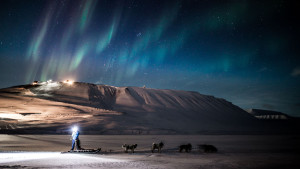
Northern lights winter
The aurora borealis has given birth to a range of myths and sagas throughout history. But what are the northern lights, and why should you travel to Svalbard to see them?
Creator of myhts
Throughout history, this dancing green light in the sky has been connected with a range of myths and sagas. The vikings believed that the aurora was reflected light from the shields born by the Valkyrie - a host of female figures who brought deceased warriors to Valhalla. But, it doesn’t stop there - the Sámi people believed they could hear the northern lights. To this day they call it ‘Guovssahas’ - the light you can hear. The Inuits thought that the northern lights were the dance of the dead, whilst the Native Americans from North Dakota believed that they were seeing flames under massive cauldrons where medicine men and warriors boiled their enemies. Even until relatively recent times, it was quite normal to tell children to come inside when the northern lights arrived - out of fear they might be taken by the aurora.
WHAT ARE THE NORTHERN LIGHTS?
The northern lights, or the aurora borealis, are caused by waves of electric particles from the sun that are hurled towards our planet. It was the Norwegian scientist, Kristian Birkeland, who discovered this around 1900. He was a famous researcher, and was nominated for the Nobel Prize seven times, although sadly he never won. Birkeland was the first to prove that when electrons from the sun collide with gasses in the Earth’s atmosphere, a very special light is formed.
Northern Lights are formed between 80 and 500 kilometres over our heads. You have the greatest chance of experiencing the aurora borealis in the northernmost parts of Scandinavia, northern Russia, Alaska and the northernmost parts of Canada, Greenland and Iceland. However, on rare occasions the lights have been reported much further south in Europe. The Northern Lights season on Svalbard is between October and early March, and the best time of night to see them is 8:00 pm to 2:00am.
NO LIGHT SWITCH FOR THIS DISPLAY
Just like all other natural phenomena, the aurora can’t be turned on or off. First of all, you will need clear skies, which can be a challenge at times. The next thing you will need is some patience. However, here at the northernmost reaches of Norway you will most likely see the northern lights on every clear night. The display often comes in waves which last about 30 minutes, before disappearing and then returning once more. Due to the polar night on Svalbard, we don’t have to wait for the night to hunt the aurora, it is dark enough in the day. This really increased your chances. In addition, Longyearbyen and its surrounds have very little light pollution, so you will see the lights more clearly. Add the stunning yet stark wilderness, and you have a winning combination!
The Austrian explorer, Julius von Payer, once described it as follows: ‘No pen can draw it, no colors can paint it, and no words can describe it in all its magnificence’. He was 100% right - it has to be experienced!
